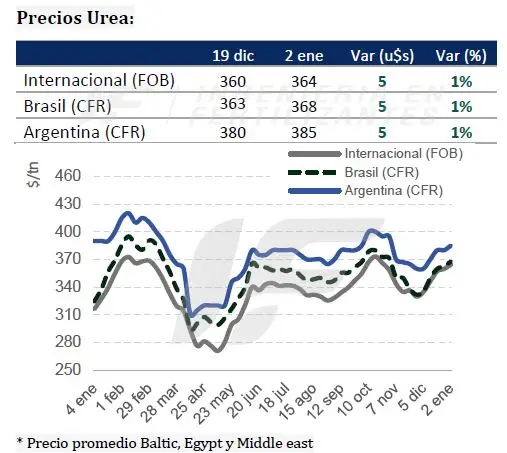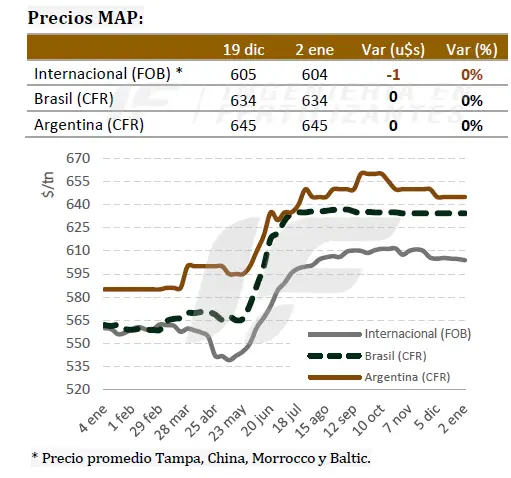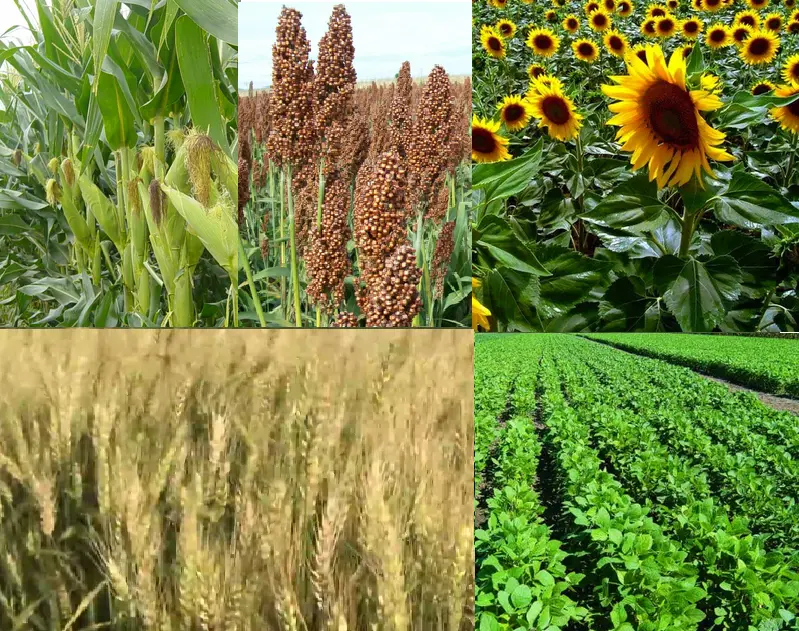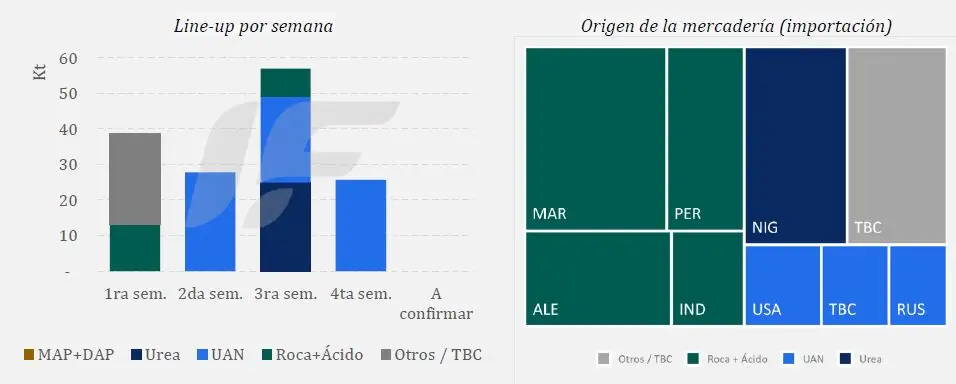
Prices of granular urea in the Argentinean market started the year with increases in line with the upward trend registered in the international market.
“The local market, despite being completely inactive during the holidays, has been following the increase in international urea prices,” says a specialized report.
“In recent weeks, this has led to an increase of around 30 u$/ton, with the possibility that this trend will continue next week,” it warns.
However, the prices of other products such as fertilizers, phosphates or liquids (the latter also with the arrival of new ships in Argentina) have remained stable.
The report points out that liquid nitrogen fertilizers (UAN) could currently have a competitive advantage over granulated urea.

“As for phosphate fertilizers, they continue to be in a state of stagnation, both in terms of prices and sales. Although available stocks are not high, they are more than sufficient to cover market demand, which is still close to zero,” the report says.
The management of fertilizer imports was reactivated towards the end of last year, thanks to the elimination of the 7.5% PAIS tax, which increased the cost of inputs entering the country.
For January, the estimated arrival of goods is 150,000 tons, mainly concentrated in inputs and liquids. “Three ships are expected to arrive with phosphate rock and two with sulfuric acid, the main inputs for the local production of phosphates. On the other hand, the arrival of two cargoes of UAN (21,000 tons) is also expected to meet summer demand and replenish liquid stocks,” the report said.
Source: Bichos de Campo – Valor Soja

The Indogulf Cropscience expands its investment in Ethiopia’s fertilizer sector
IndoGulf Cropsciences, a leading Indian agrochemical and fertilizer manufacturer, is set to enhance its investment in Ethiopia’s fertilizer production industry. This move was discussed during a meeting between Fesseha Shawel, the Ethiopian Ambassador to India, and Sanjay Aggarwal, Managing Director of IndoGulf Cropsciences.
The discussions focused on the potential for manufacturing agrochemicals and fertilizers directly in Ethiopia, building on IndoGulf’s existing export relationships. Ambassador Shawel highlighted the favorable investment climate in Ethiopia’s agricultural sector, emphasizing the country’s recent macroeconomic reforms and liberalization of the financial sector, which are aimed at attracting more foreign direct investment.
The Embassy of Ethiopia in New Delhi expressed optimism about this partnership, noting that such investments are crucial for the growth of Ethiopia’s agrochemical industry and can significantly contribute to the agricultural sector’s development.
Source: Fertilizers Daily
ARGENTINE MAIN CROPS OVERVIEW:

WHEAT: Finally, wheat harvest is nearing completion, with 94.7% of the suitable area harvested to date. Before the recent rainfall in southeastern Buenos Aires, a weekly progress of 6.2 p.p. was recorded. Yields in the southern agricultural area continue to show significant variability across regions, ranging from 2.5 to 4.7 tons/ha, resulting in a national average yield of 3.03 tons/ha. As noted in our previous report, the remaining unharvested areas play a crucial role in determining the final production volume, and the final figure will depend on the results from these regions as the campaign concludes.
SOYBEANS: Following a weekly progress of 8 percentage points (p.p.), soybean planting now covers 92.7% of the projected 18.4 million hectares (MHa) for the 2024/25 season. Planting is advancing at a good pace in the northern agricultural region, where coverage has reached 73%. At the national level, 81% of the already planted area is reported to have Adequate/Optimal moisture conditions, a 7 p.p. decrease from the previous report due to higher water demand from early-planted crops and uneven rainfall distribution. Despite this, 93% of the plots maintain a Normal/Good crop condition, which will depend on future rainfall. Currently, 32% of the first-crop soybeans have entered reproductive stages, while 86% of the second-crop soybeans have been planted, with the remaining area requiring additional moisture to complete sowing.
CORN: In the last seven days, planting of corn for grain advanced by 6.5 p.p., reaching 87.4% of the estimated 6.6 MHa for the current season. Recent rains in Córdoba and southern Buenos Aires have improved prospects for late-planted corn, facilitating the completion of planting in these regions. However, at the national level, the share of crops with Adequate/Optimal moisture conditions decreased by 6.8 p.p. due to high temperatures and a lack of rainfall in the central-eastern agricultural region. While this situation has affected soil moisture, it has not yet caused significant impacts on crop development, except in the Southern Core Region, where early signs of water stress, such as yellowing of basal leaves, are being observed, potentially affecting yields
SUNFLOWER: The combination of insufficient rainfall, high temperatures, and increased water demand from the crop has significantly depleted soil moisture reserves. Currently, 62.4% of the sunflower area is reported to have Adequate/Optimal moisture conditions, a 2.3 p.p. decrease compared to the previous week. The lack of significant rainfall in the short-term forecast is raising concerns among producers. Although 100% of the area is still reported to be in Normal/Excellent condition, this could rapidly deteriorate if the current scenario persists. Nevertheless, in early-harvest regions, initial yields from preliminary harvests are averaging 1.88 tons/ha, and expectations for the remaining standing crops are promising.
SORGHUM: The Sorghum planting has progressed significantly across much of the agricultural area over the past fifteen days, reaching 80.8% of the projected total. In the northern agricultural region, planting has reached 47%, while in the central region, planting activities are nearly complete, with only a few hectares remaining in the central-west. Regarding phenological development, fields in the central region are observed at various stages, from vegetative growth to early heading. Reports from regional collaborators indicate isolated issues with seed quality. Additionally, pest monitoring and control continue, particularly for yellow sugarcane aphid and fall armyworm, which pose a threat to crop development.
Source: Buenos Aires Stock Grain


